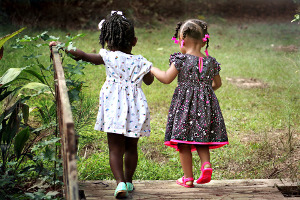Psychology Addict # 7 | Children´s Understanding of Friendship

Betty and Jenny in the playground – They are both 3 years old.
Betty to Jenny: I do like you, Jenny ... I do.
Jenny to Betty: I know it.
Betty to Jenny: Yeah. But I just ran away from you. You know why?
Jenny to Betty: Why?
Betty to Jenny: You wanted to play with Linda?
Betty to Jenny: Yeah.
Jenny to Betty: I ranned away with you. Wasn’t that funny?
Betty to Jenny: Yes.
Jenny to Betty: Cause I wanted to know what happened.
Betty to Jenny: I know you wanted – all the time – you wanna know because you are my best friend.
Jenny to Betty: Right
Early Studies
What the above transcript conveys is how worried the children were about how the other felt when they went away to play with another child. However, Psychological research conducted in the 70’s stated that consideration and concern only developed much later on in childhood.
In the 70’s when researchers’ focuses mainly lay on studying attraction and similar variations of emotional relationships, John La Gaipa and Bigelow took the opposite direction. They were interested in children’s understanding of friendship.
To gather insight into how children perceive their friends, what (in the children’s opinion) constitutes friendship, and very importantly, what they expect from those who they call friends; the psychologists conducted an approach called content analyses in which they examined written material.
The Research & The Findings
480 children, out of 8 schools in Canada, were selected to write an essay. 30 boys and 30 girls were recruited out of each school. Overall they were aged between 6 and 14 years. They were from lower-middle-class and upper-middle-class households. The analyses of the essays consisted of comparing the accounts of older and younger children, as well as that of boys and girls.
The essays indicated to La Gaipa and Bigelow that as a child grows older there is a shift from interests and understandings, which goes from shared activities at early ages, to focusing on trust, intimacy and common values, as the child gets older. They also inferred that there was little complexity in how younger children saw their friends. Regarding the difference between boys and girls’ expectations and understanding of friendship, only a minor difference was found: the emphasis that boys placed on organised play.
This is an important study as it draws attention to the ways friendship is perceived and progresses throughout childhood and teen years. There is, nonetheless, a great limitation in it, which is their very approach.
Small children demonstrate regard and concern towards their friends.
Young children can not reveal the complexities existent in the ways they form and maintain relationships on a written essay.
To address this William Corsaro adopted an ethnographical approach – where he observed at length and took part in children’s activities. It was his study that debunked the knowledge that young children have small expectation of their friends, and little understanding of what friendship means.

In the transcript above, Corsaro highlights Betty’s worry towards Jenny by reiterating they are still best friends and that she understands why Jenny wanted to know where she was!
Making and maintaining friends is an important skill to have. And as demonstrated by psychological research this is something that takes place at a very early stage. It is important that parents facilitate this process as it will only provide their kids with ample opportunities to practice a very important role in life, that of being a good friend.
Reference List:
Bigelow, B.J and La Gaipa, J. (1975) ‘Children’s written description of friendship: a multidimensional analyses’, Developmental Psychology, vol.11, no. 6, pp. 857-8.
Corsaro, W.A (1985) Friendship and Peer Culture in the Early Years, New Jersey, NJ, Ablex Publishing Corporation.
Join us on #steemSTEM / Follow our curation trail on Streemian
Thank you for this very interesting article. It has been advertised on our chat channel (and upvoted).
The steemSTEM project is a community-supported project aiming to increase the quality and the visibility of STEM (STEM is the acronym for Science, Technology, Engineering and Mathematics) articles on Steemit.
Thank YOU @steemstem!
May God protect these beautiful children
Amen.
very good and nice post i am nazia from pakistan i am new user of steemit i m student.